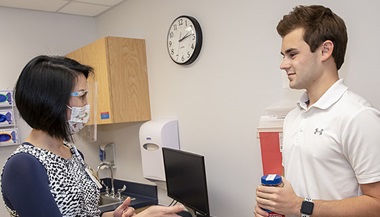Dealing with Allergic Reactions in Children
Featured Expert
Food Allergy Reactions in Kids
An allergic reaction is an immune system response to a substance the body mistakenly believes is harmful. On this week’s On Call for All Kids, Panida Sriaroon, M.D., an allergy specialist at Johns Hopkins All Children’s Hospital who leads the hospital’s Food Allergy Clinic, explains how parents can spot an allergic reaction in children.
Our immune system protects us from invading organisms that can cause illness. If you have an allergy, your immune system mistakes an otherwise harmless substance as an invader. When a person with food allergy eats the food, their immune system releases massive amounts of chemicals, including histamine, that trigger a cascade of symptoms that can affect the respiratory system, the gastrointestinal tract, the skin, and/or the cardiovascular system.
The most common allergic reactions are to foods, insect stings and medications.
What are the symptoms of an allergic reaction?
For an acute allergic reaction, the child will develop one or more of the following symptoms within a few minutes to an hour after having an exposure to the trigger. Only a few of these symptoms may be present:
- Skin: Itching, hives, redness, swelling
- Mouth: Itching, swelling of lips and/or tongue
- Throat: Itching, tightness, closure, hoarseness
- Gut: Vomiting, diarrhea, cramps
- Lung: Shortness of breath, cough, wheeze
- Heart: Weak pulse, dizziness, passing out
How is anaphylaxis different from an allergic reaction?
Anaphylaxis is a term used to describe a serious allergic reaction that comes on quickly, has the potential to become life-threatening and needs immediate medical treatment. If it isn’t treated properly, anaphylaxis can be fatal.
Are allergic symptoms in young kids different from those older kids or adults?
Young children can’t always clearly explain their symptoms, so sometimes parents have to interpret what the child is feeling. The first sign before these symptoms develop may include changes in their demeanor, sometimes even before other symptoms (hives, swelling, cough, and vomiting). In case of an allergic reaction to food, the baby/young toddler might refuse to eat the food further after the first few bites.
Your child might be having an allergic reaction if they say something like:
- “There’s something stuck in my throat.”
- “My tongue is too big.”
- “My mouth itches.”
What should parents do when they suspect their child is having an allergic reaction?
Most parents have no idea if their children have food allergies until they try the food for the first time and have a reaction. That’s why it’s important for parents — as well as teachers, babysitters, and everyone else who spends time with the child — to be alert for signs of a food allergy.
If the child has a known history of allergies or had a previous allergic reaction, the caregiver should pay attention to the child’s system areas, which are the skin, the respiratory system and the gastrointestinal tract.
FOR MILD SYMPTOMS FROM A SINGLE SYSTEM AREA:
- Antihistamines may be given, if ordered by a health care provider
- Stay with the person; alert emergency contacts
- Watch closely for changes. If symptoms worsen, give epinephrine
FOR ANY SEVERE SYMPTOMS OR MILD SYMPTOMS FROM MORE THAN ONE SYSTEM AREA:
- INJECT EPINEPHRINE IMMEDIATELY
- Call 911. Tell emergency dispatcher the person is having an allergic reaction and may need epinephrine when emergency responders arrive.
- Consider giving additional medications following epinephrine:
- Antihistamine
- Inhaler (bronchodilator) if wheezing
- Lay the person flat, raise legs and keep warm. If breathing is difficult or child is vomiting, let them sit up or lie on their side.
- If symptoms do not improve, or symptoms return, more doses of epinephrine can be given about five minutes or more after the last dose.
- Alert emergency contacts.
- Transport patient to emergency department, even if symptoms resolve. (During the COVID-19 pandemic, if epinephrine is administered early and symptoms markedly improve quickly without a rebound, a health care provider may approve observation of the child at home.)
What is the current food allergy situation?
As of May 2021, there are as many as 32 million Americans, including six million children, affected by food allergies. The prevalence is increasing. It is estimated that about 1 out of every 13 children is allergic to at least one food. The most common food allergy triggers in kids:
- cow’s milk
- eggs
- peanuts
- tree nuts (walnuts, almonds, cashews, pistachios)
- fish
- shellfish (shrimp, crab, lobster)
- soy
- wheat
- sesame
About 40 percent of those children have experienced severe, life-threatening reactions.
On Call for All Kids is a weekly series featuring Johns Hopkins All Children's Hospital experts.
Allergy and Immunology at Johns Hopkins All Children's Hospital








